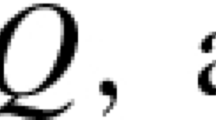Abstract
In this paper, we study the likelihood ratio tests for situations in which the null and alternative hypotheses are determined by two polyhedral cones,C 1 andC 2, which are nested so thatC 1 ⊂L ⊂C 2 andL is a linear space. The two cones are proved to be non-oblique. Members which satisfy this nesting condition are easily identified and include the cases in whichC 1=L orL=C 2. When testing two non-oblique hypotheses with variances unknown, the least favorable point within the null hypothesis has not been determined in general. However, for the situation considered here, the zero vector is shown to be least favorable within the null hypothesis. Two sets of hypotheses are said to be equivalent if they lead to the same likelihood ratio test. For two non-oblique polyhedral cones,C 1 andC 2, four sets of equivalent hypotheses are identified. IfC 1 ⊂L ⊂C 2, then the two cones in each of these four sets of hypotheses are similarly nested with a linear space in between.
Similar content being viewed by others
References
Bachman, G. and Narici, L. (1972).Functional Analysis, Academic Press, New York.
Bartholomew, D. J. (1959). A test of homogeneity for ordered alternatives,Biometrika,46, 36–48 and 328–335.
Bartholomew, D. J. (1961). A test of homogeneity of means under restricted alternatives (with discussion),J. Roy. Statist. Soc. Ser. B,23, 239–281.
Hestenes, M. R. (1975).Optimization Theory, Wiley, New York.
Hogg, R. V. and Craig, A. F. (1978).Introduction to Mathematical Statistics, Macmillan, New York.
Menendez, J. A. and Salvador, B. (1991). Anomalies of the likelihood ratio test for testing restricted hypotheses,Ann. Statist.,19, 889–898.
Menendez, J. A., Rueda, C. and Salvador, B. (1992a). Dominance of likelihood ratio tests under cone constraints,Ann. Statist.,20, 2087–2099.
Menendez, J. A., Rueda, C. and Salvador, B. (1992b). Testing non-oblique hypotheses,Comm. Statist. Theory Methods,21, 471–484.
Raubertas, R. F., Lee, C. I. C. and Nordheim, E. V. (1986). Hypothesis tests for normal means constrained by linear inequalities,Comm. Statist. Theory Methods,15, 2809–2833.
Robertson, T. and Wegman, E. J. (1978). Likelihood ratio tests for order restrictions in exponential families,Ann. Statist.,6, 485–505.
Robertson, T., Wright, F. T. and Dykstra, R. L. (1988).Order Restricted Statistical Inferences, Wiley, New York.
Shapiro, A. (1985). Asymptotic distribution of test statistics in the analysis of moment structures under inequality constraints,Biometrika,72, 133–144.
Warrack, G. and Robertson, T. (1984). A likelihood ratio test regarding two nested but oblique order restricted hypotheses,J. Amer. Statist. Assoc.,79, 881–889.
Zarantonello, E. H. (1971). Projections on convex sets in Hilbert space and spectral theory,Contributions to Nonlinear Functional Analysis (ed. E. H. Zarantonello), 237–424, Academic Press, New York.
Author information
Authors and Affiliations
Additional information
This research was supported in part by the National Institutes for Health under Grant 1 R01 GM42584-01A1.
Part of this work is taken from this author's dissertation submitted in partial fulfillment for the Ph.D. Degree at the University of Missouri-Columbia.
About this article
Cite this article
Hu, X., Wright, F.T. Likelihood ratio tests for a class of non-oblique hypotheses. Ann Inst Stat Math 46, 137–145 (1994). https://doi.org/10.1007/BF00773599
Received:
Revised:
Issue Date:
DOI: https://doi.org/10.1007/BF00773599



